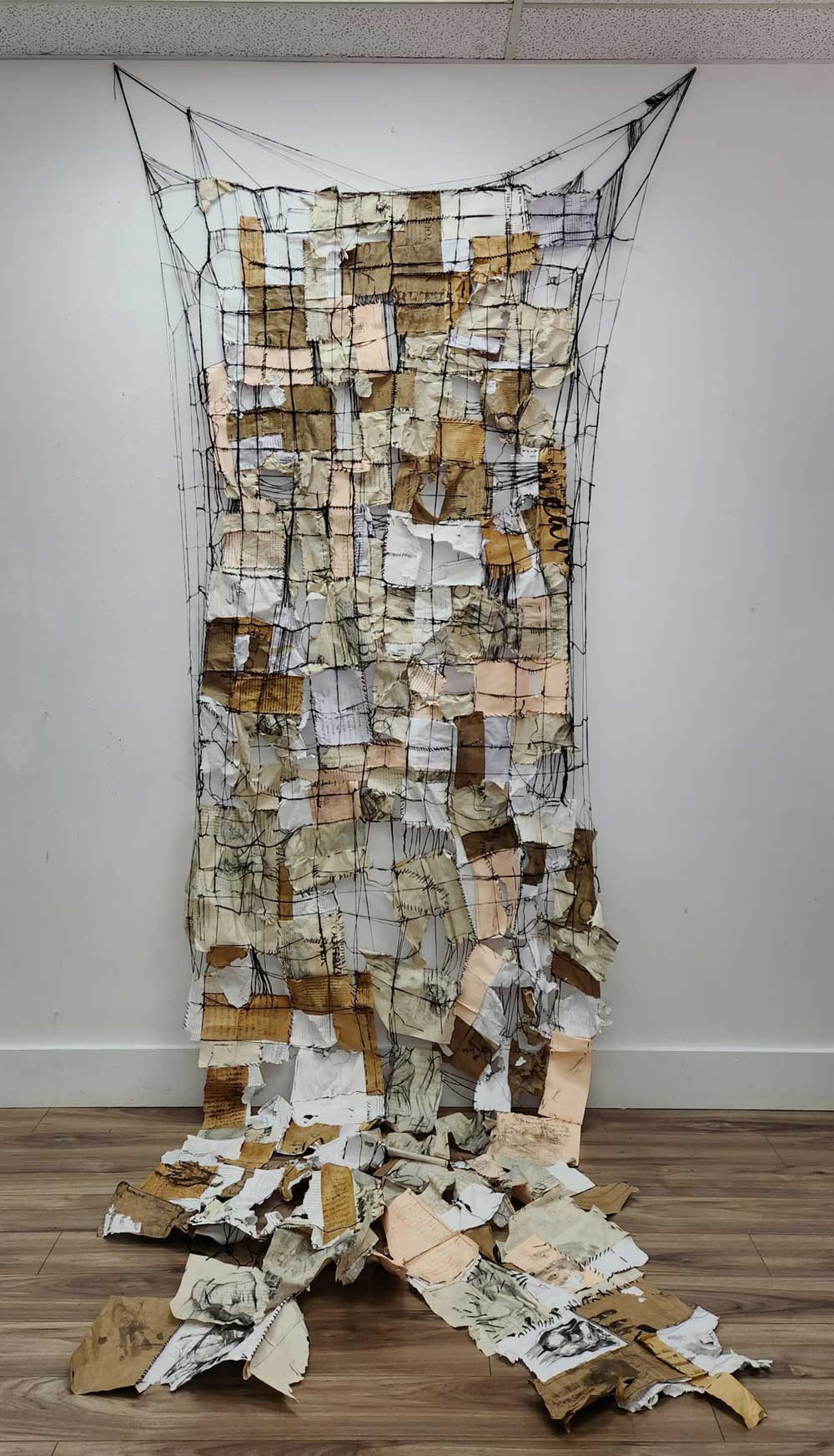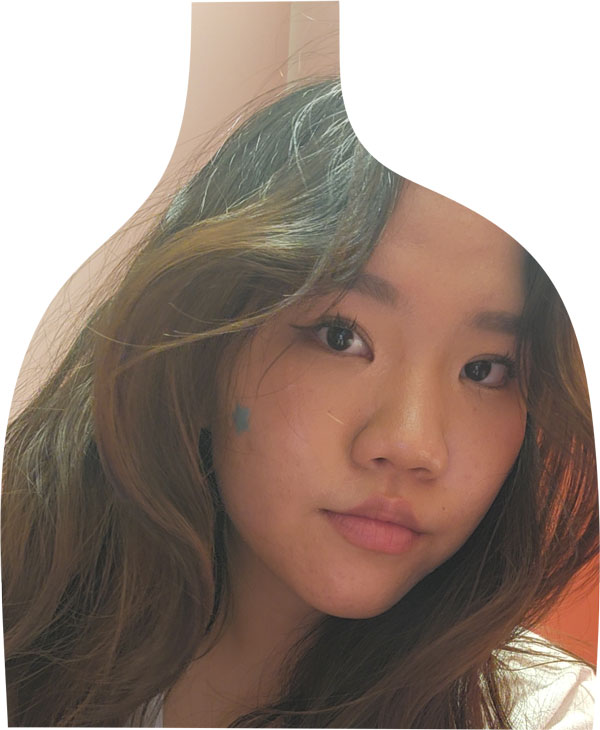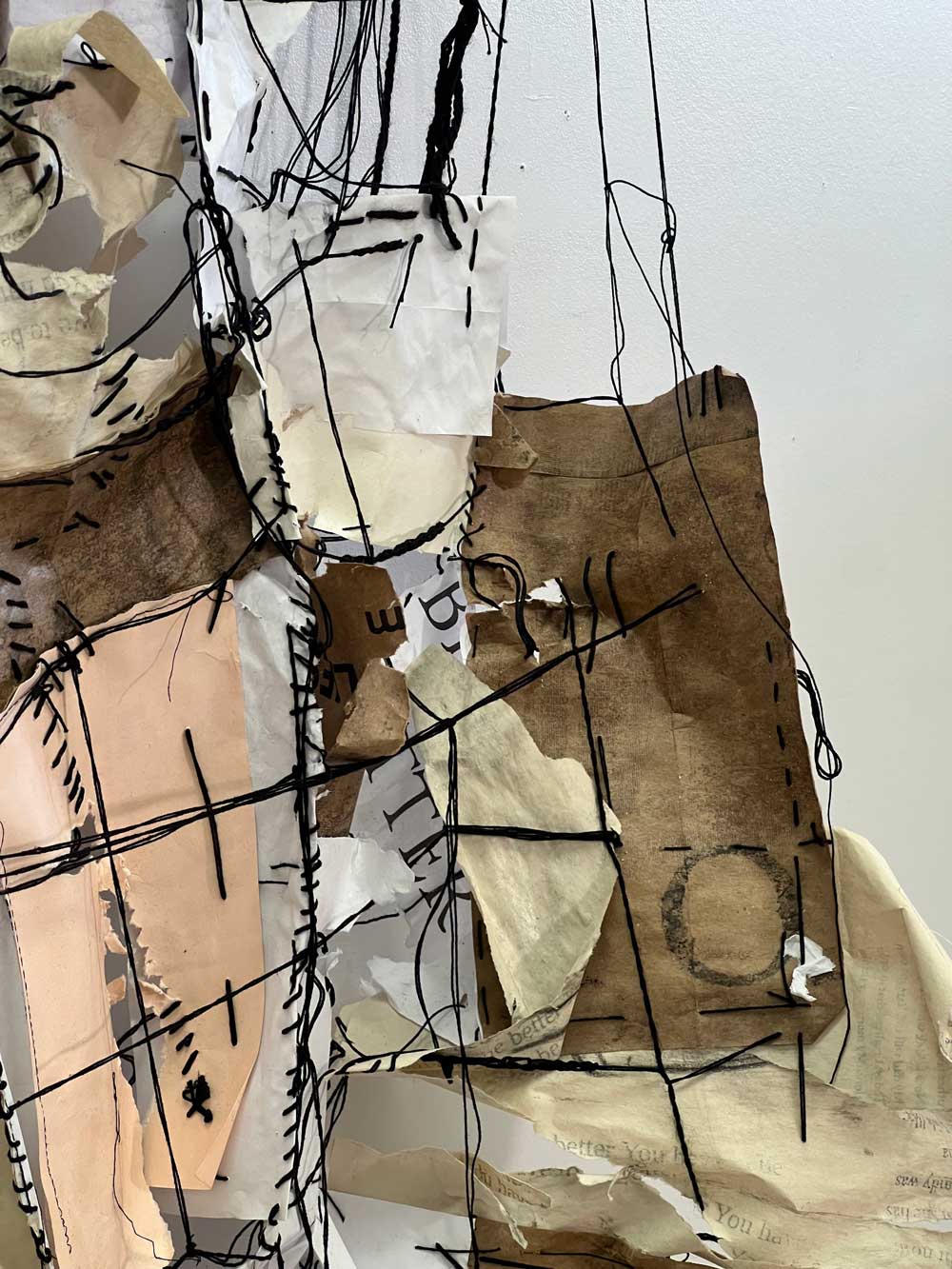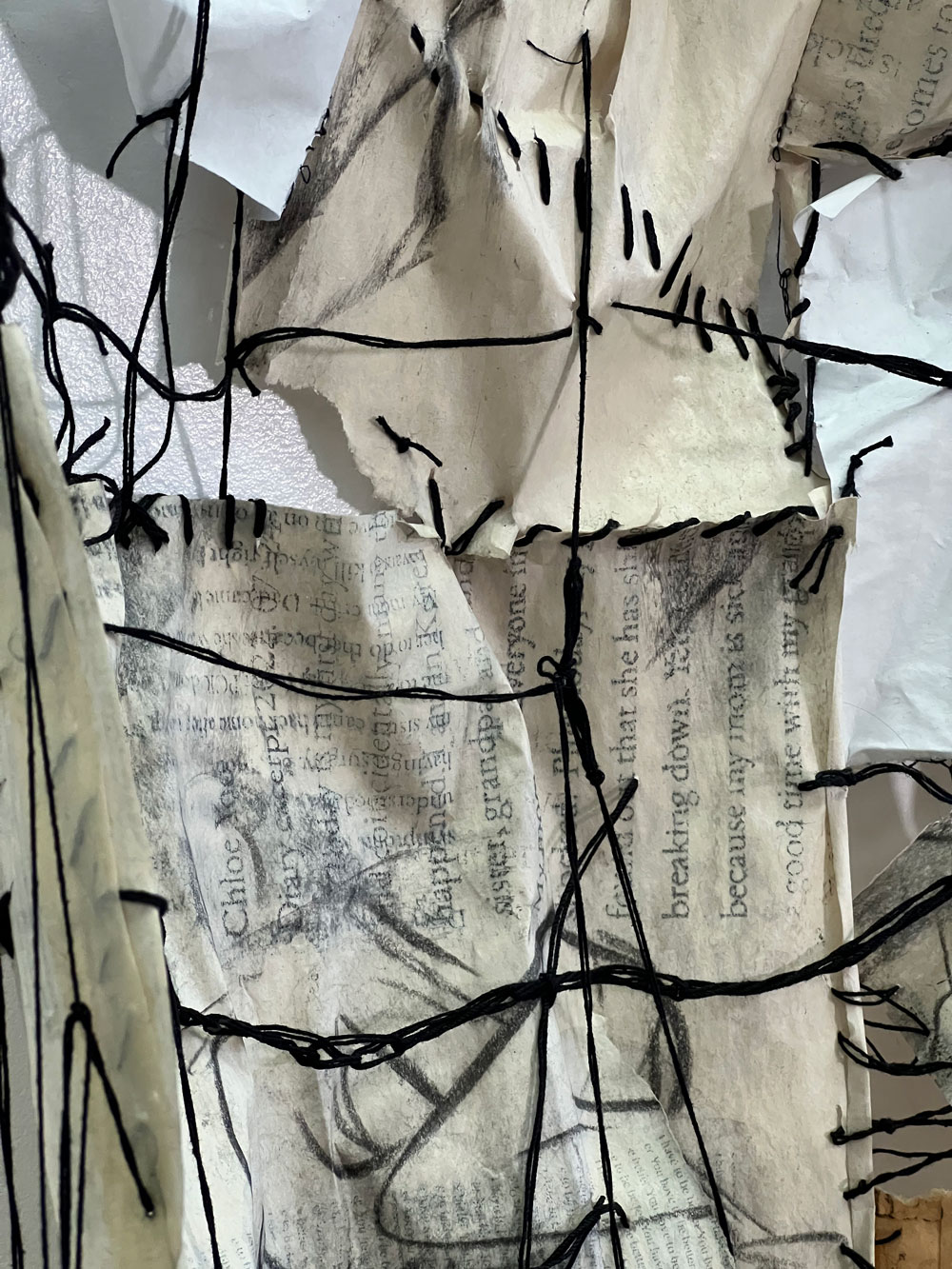

The Net of Words I

Height: 112" x Width: 30" x Depth: 55" | Material(s): Paper, digital printer, glue, water, and yarn | Process(es): Net made of stitched paper, printed on various papers to convey contrasting effects of same words | Idea(s): Convey power of words with my own printing method, heavily printing explore the words' weight | Curatorial Note: The net installation explores a unique approach to 3-D Art and Design. It encompasses space that begins at the ceiling of the space and cascades down and continues into the floor for several feet. The artwork is symbolic of a current of the power of words coming to life three-dimensionally.
Chloe Yoo


Student statement
Student statement
Please describe the context for how the idea for this artwork originated (was this part of your sustained investigation, an independent project, a class assignment, created during a summer study, etc.).
This work is part of the “Net Project,” a series of works created as a project for university admission. The Net project was developed based on my personal experience in the summer of 2022, where something I used to believe would stay resilient shattered completely. In the process of confronting reality, I was laid upon words from the closest individuals. Although they were words that we use normally in our daily lives, it felt as if they were demanding to take away a part of myself. Eventually, these words piled up in my mind and overwhelmed me to the point that it was suffocating. I felt like a captured fish when I confronted these complex words. This experience led me to question the power of words. Words have significant power: They can alter one’s perspective, give incurable scars, soothe one’s mind, and motivate others. Inspired by these ideas, my investigation visualizes various scars from the words and explores their weight, invincible power, and complexity. Throughout the process, I also questioned how the process and art can heal my scars. Later, I applied artistic practices that would destroy the pessimistic representation of the works. It questions how art can be used as a tool to heal scars.
In what ways did you practice and experiment when developing your sustained investigation?
The power of words is explored with printing methods using a digital printer, a machine that is capable of mass-producing the same things over and over. I saw a resemblance between the burden of words and mass production. The weight of words is explored using heavy printing of words on surfaces. The invincible power of words is shown by investigating materials that create tension—nylon and wire, yarn and paper. Scars are shown with red yarn, representing blood; healing and resistance are shown by applying bandages and processes that would destroy the pessimistic representation of these works. The Net of Words I references the process. I experimented with printing techniques; I typed words, printed them on film paper, and stamped them on other types of paper (paper bags, newspaper, newsprint paper, etc.). I incorporated different surfaces of paper to execute different textures and to convey how consuming the same words that are repetitively said feel different.

Synthesis of ideas and materials is shown using various forms of printed text and altering words into new iterations of power.
How did you demonstrate revision in your sustained investigation?
I demonstrated revision in my sustained investigation by questioning how art can be used as a tool to heal the wounds from past experiences. For example, I utilized the symbolism of plaster and Band-Aid within the portfolio, recognizing the whiteness of plaster as a wound that is concealed and healed. Throughout the process, I revisited the Net of Words I, crushed it into a form, and concealed the words and yarns with white paint. This process represented my will to seal the words and metaphorically represent the whiteness of the transformed work with plaster and Band-Aid. The action of revisiting, crushing, and concealing the past work represents my action of confronting the wound from words.
How did your materials and process(es) choices shape the creation or meaning of your artwork(s)?
My material choice and processes shaped the meaning of my works significantly. For example, when someone says something to me one time, it seems insignificant. However, as I hear phrases repeated, they become burdensome, and they pile up in my mind. I connect this concept with paper and utilize it metaphorically. One piece of paper is light, but multiple pieces are heavy. The process of printing continuously on the surfaces emphasizes the repetition of the same words that I heard from different individuals. My material choice of Band-Aid and plaster refers to my attempt to conceal and “heal” the marks that metaphorically represent scars, like the torn nylon socks. Applying plaster and Band-Aids on different works led to transforming every work to have a white surface, which creates a symbol with the color white. Eventually, the works that are revised with “white” (plaster) represent wounds that are healed and concealed.
How did your art teacher support your artistic development?
He exposed me to various materials and discussed with me the direction of portfolio. He helped me to be conscious of how my action within the creation of art will shape how I speak the visual language.


Kory Bogen
Secondary Visual Art Teacher
Handsworth Secondary, North Vancouver, BC, Canada
Teacher statement
Teacher statement
The AP Art and Design course supports inquiry-based personalized learning in the sustained investigation portfolio component. What strategies helped you guide students through inquiry?
Starting early with writing, mind maps, word association, and asking questions on social media polls, etc. are great ways to begin inquiry. Asking peers, family members, etc. for ideas takes the onus away from students and allows them to have a greater abundance of ideas to work from.
How did you scaffold writing into the art-making and thinking processes?
Writing needs to start at the beginning of the course. Students revise their 600-character statements every few weeks to match the work they are creating. The writing can—and should—reflect where the student is currently in their development of the portfolio. Sentence stems and fill-in-the-blank templates work great as a tool to encourage writing early on.
Material(s): Paper, digital printer, glue, water, and yarn | Process(es): Print experimentation—different surfaces convey the same words, bring disparate elements together | Idea(s): My investigation visualizes various effects of words on my mind and explores their weight, invincible power, and complexity.
How did you structure practice, experimentation, and revision into your AP Art and Design curriculum?
I like to have students work on multiple pieces at the same time and allow for their experimentation to factor into many creations at once. Having students repurpose/take apart their work after it is finished is also a great way to create cohesion in the portfolio through revision.
Material(s): Sketchbook | Process(es): Thought processes of conveying wound and weight of words/revising to depict the healing process
How do you support your students in the Selected Works portfolio component?
Having other students do a blind read of the works to choose those that best show inquiry is a great way to start, or to have other classes do the same for the students. It is a good idea to constantly remind students to update their Materials, Processes, and Ideas boxes.
What did you learn from working with your student?
I have learned to trust my AP students. They are always willing to apply constructive feedback, but this is a program where students are in charge, and sometimes letting them take big risks results in big payoffs.
Chloe Yoo

